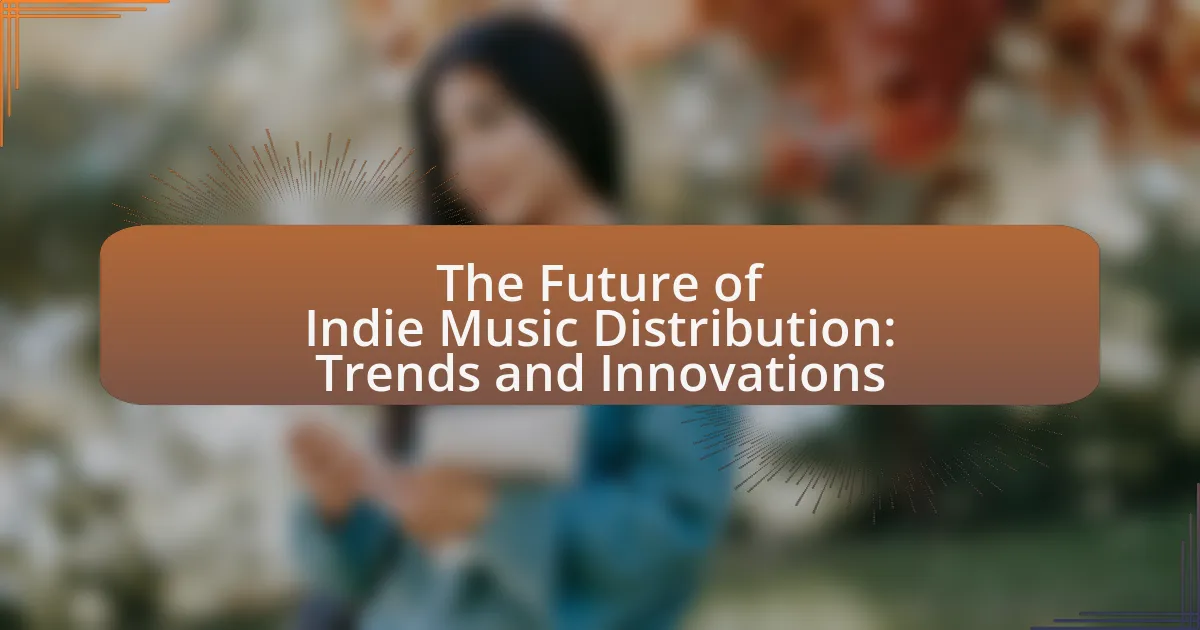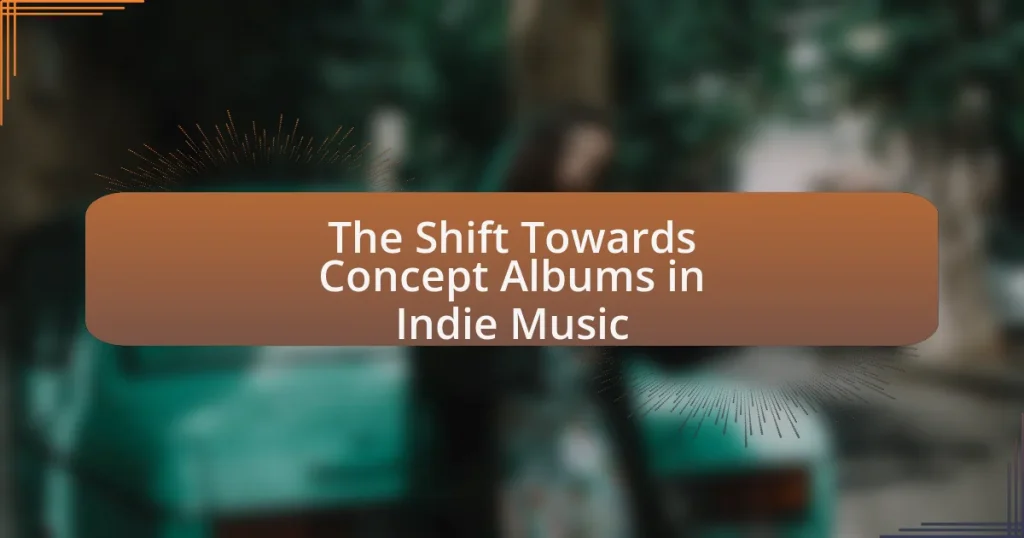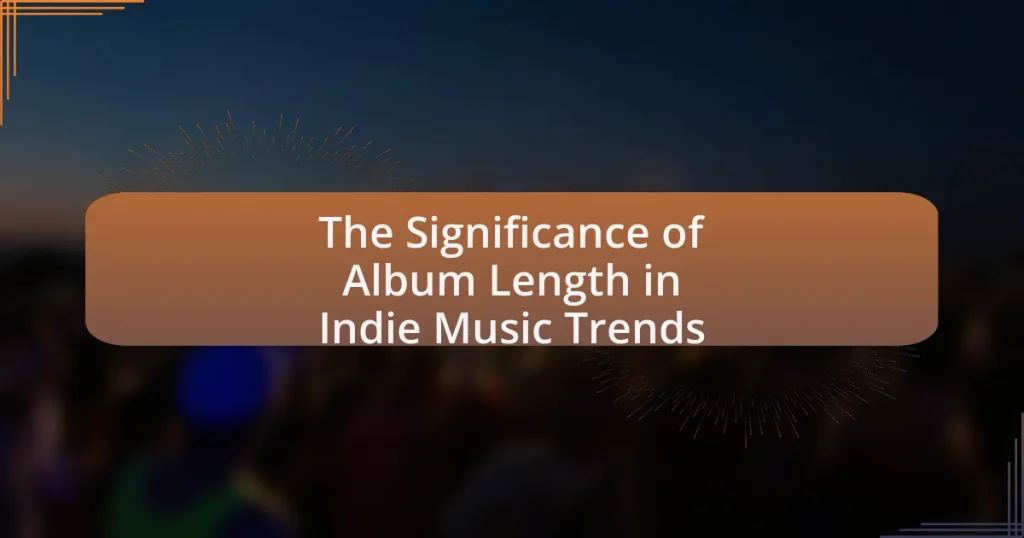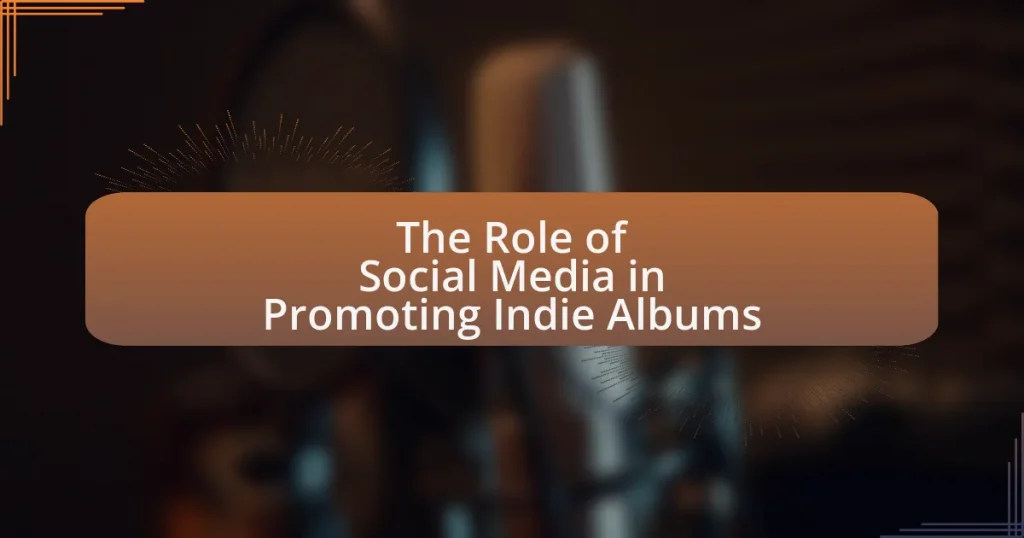The article focuses on the evolving landscape of indie music distribution, highlighting current trends and innovations that are reshaping the industry. Key topics include the rise of direct-to-fan platforms, the impact of streaming services, and the role of social media in promoting indie artists. It also examines emerging business models such as crowdfunding and NFTs, as well as the significance of data analytics in optimizing marketing strategies. Additionally, the article addresses the challenges indie artists face, including financial constraints and legal issues, while offering practical strategies for successful distribution in a competitive market.
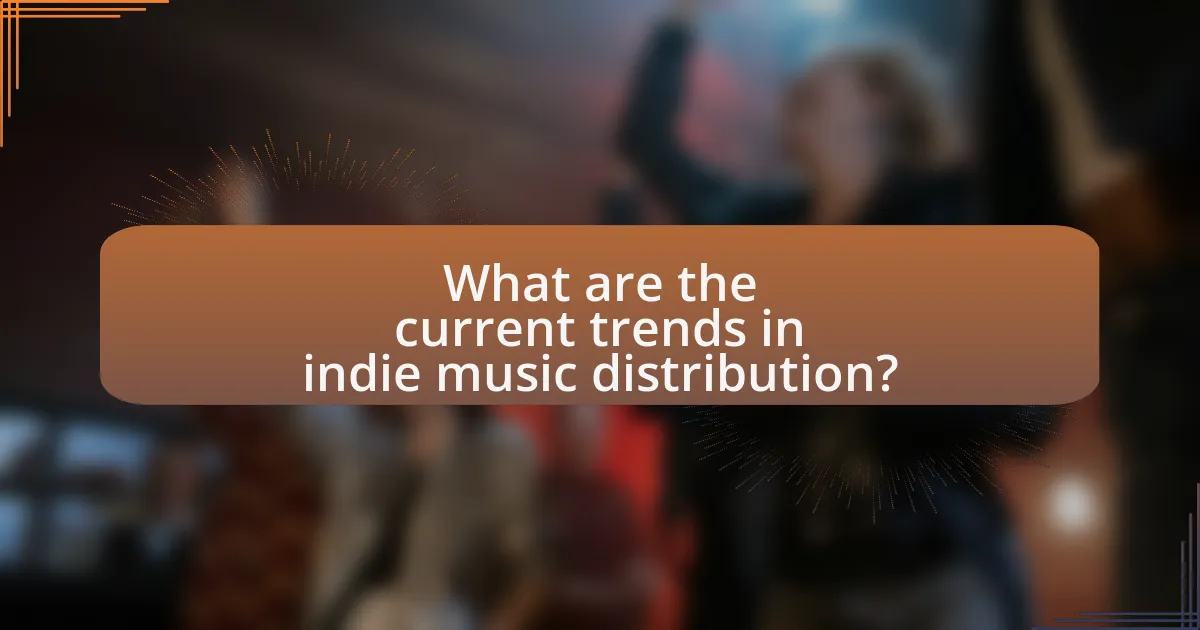
What are the current trends in indie music distribution?
Current trends in indie music distribution include the rise of direct-to-fan platforms, increased use of social media for promotion, and the growing importance of data analytics. Direct-to-fan platforms like Bandcamp and Patreon allow artists to sell music and merchandise directly to their audience, enhancing revenue and fan engagement. Social media channels, particularly TikTok and Instagram, have become essential for indie artists to reach new listeners and promote their work, with viral trends significantly impacting music discovery. Additionally, data analytics tools are increasingly utilized by indie musicians to understand listener behavior and optimize marketing strategies, enabling more targeted outreach and effective distribution. These trends reflect a shift towards greater autonomy for artists in managing their careers and connecting with fans.
How is technology shaping the landscape of indie music distribution?
Technology is significantly shaping the landscape of indie music distribution by enabling artists to reach global audiences directly through digital platforms. The rise of streaming services like Spotify and Bandcamp allows independent musicians to distribute their music without the need for traditional record labels, which historically controlled distribution channels. According to a report by the International Federation of the Phonographic Industry (IFPI), over 70% of music consumption now occurs through streaming, highlighting the shift in how music is accessed and consumed. Additionally, social media platforms facilitate direct engagement between artists and fans, further democratizing the distribution process. This technological evolution not only reduces costs associated with physical distribution but also provides valuable data analytics for artists to understand their audience better, ultimately transforming the indie music landscape.
What role do streaming platforms play in indie music distribution?
Streaming platforms serve as crucial channels for indie music distribution by providing artists with direct access to a global audience. These platforms, such as Spotify and Apple Music, enable independent musicians to upload their music without the need for traditional record labels, thus democratizing the distribution process. According to a 2021 report by the International Federation of the Phonographic Industry (IFPI), over 60% of music consumption now occurs through streaming services, highlighting their dominance in the industry. This shift allows indie artists to reach listeners worldwide, gain exposure, and generate revenue through streaming royalties, which are increasingly significant in the music economy.
How are social media and digital marketing influencing indie artists?
Social media and digital marketing are significantly influencing indie artists by providing them with platforms to reach wider audiences and engage directly with fans. These tools enable artists to promote their music, share content, and build a personal brand without the need for traditional record labels. For instance, platforms like Instagram and TikTok have become essential for music discovery, with statistics showing that 67% of users discover new music through these channels. Additionally, digital marketing strategies, such as targeted advertising and social media campaigns, allow indie artists to effectively reach specific demographics, enhancing their visibility and potential for success in a competitive market.
What are the emerging business models for indie music distribution?
Emerging business models for indie music distribution include direct-to-fan sales, subscription services, and decentralized platforms. Direct-to-fan sales allow artists to sell music and merchandise directly to their audience, enhancing profit margins and fostering closer relationships with fans. Subscription services, such as Patreon, enable artists to receive ongoing support from fans in exchange for exclusive content, creating a sustainable income stream. Decentralized platforms, like blockchain-based services, offer artists more control over their distribution and revenue, reducing reliance on traditional intermediaries. These models reflect a shift towards greater autonomy for indie artists in the digital landscape, as evidenced by the increasing number of artists successfully utilizing these approaches to monetize their work.
How do direct-to-fan sales impact indie artists?
Direct-to-fan sales significantly enhance the financial stability and creative control of indie artists. By selling directly to their audience, these artists can retain a larger percentage of revenue compared to traditional distribution methods, where intermediaries take a substantial cut. For instance, platforms like Bandcamp allow artists to set their own prices and receive up to 85% of sales, which is a stark contrast to the typical 10-20% they might earn through record labels. This model not only increases their earnings but also fosters a closer relationship with fans, leading to increased loyalty and support. Furthermore, direct-to-fan sales enable indie artists to experiment with pricing and product offerings, such as exclusive merchandise or limited edition releases, which can further boost their income and brand identity.
What is the significance of crowdfunding in music distribution?
Crowdfunding is significant in music distribution as it empowers independent artists to finance their projects directly through fan support. This model allows musicians to bypass traditional funding sources, such as record labels, and retain greater control over their creative output. According to a 2020 study by the Berklee College of Music, 38% of independent artists reported using crowdfunding platforms like Kickstarter and Indiegogo to fund their albums, demonstrating its growing role in the industry. Additionally, crowdfunding fosters a direct connection between artists and their audience, enhancing fan engagement and loyalty, which is crucial in the competitive music landscape.
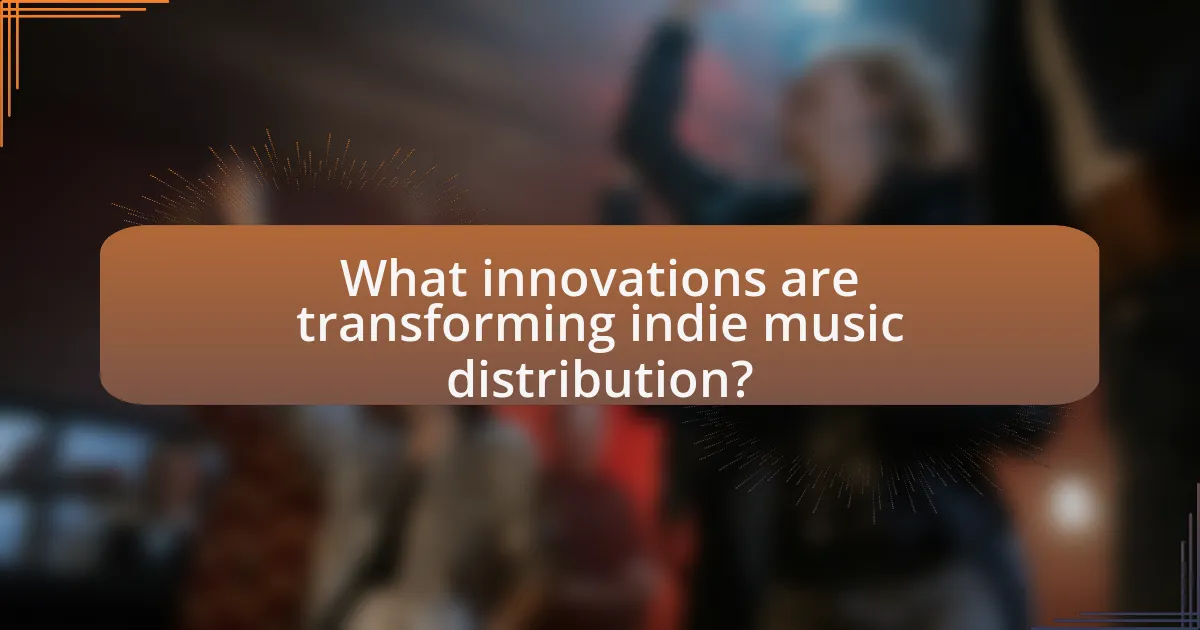
What innovations are transforming indie music distribution?
Innovations transforming indie music distribution include digital platforms, blockchain technology, and data analytics. Digital platforms like Bandcamp and DistroKid enable artists to distribute their music directly to consumers, bypassing traditional record labels. Blockchain technology offers transparent royalty tracking and ensures artists receive fair compensation for their work. Data analytics tools provide insights into listener behavior, allowing indie artists to tailor their marketing strategies effectively. These innovations collectively enhance accessibility, transparency, and profitability for independent musicians.
How are blockchain and NFTs changing the music distribution paradigm?
Blockchain and NFTs are revolutionizing the music distribution paradigm by enabling artists to retain greater control over their work and directly monetize their creations. Through blockchain technology, artists can securely register their music, ensuring transparent ownership and provenance, which reduces the risk of piracy and unauthorized use. NFTs, or non-fungible tokens, allow musicians to sell unique digital assets, such as songs or album art, directly to fans, creating new revenue streams. For instance, in March 2021, the band Kings of Leon released an album as an NFT, generating over $2 million in sales. This shift empowers independent artists by bypassing traditional intermediaries, such as record labels and streaming platforms, thus allowing them to capture a larger share of the profits.
What advantages do blockchain technologies offer to indie musicians?
Blockchain technologies offer indie musicians enhanced control over their music rights and revenue streams. By utilizing smart contracts, musicians can automate royalty payments, ensuring they receive fair compensation directly from listeners without intermediaries. This technology also provides transparent tracking of music usage, allowing artists to monitor how their work is distributed and consumed. According to a report by the World Economic Forum, blockchain can reduce transaction costs and increase efficiency in the music industry, which is particularly beneficial for independent artists who often face financial barriers. Additionally, blockchain enables direct fan engagement through tokenization, allowing musicians to create unique experiences and build loyal communities around their work.
How can NFTs provide new revenue streams for artists?
NFTs can provide new revenue streams for artists by enabling them to sell unique digital assets directly to consumers. This direct-to-consumer model eliminates intermediaries, allowing artists to retain a larger share of the profits. Additionally, NFTs can include smart contracts that enable artists to earn royalties on secondary sales, ensuring ongoing revenue as their work appreciates in value. For instance, a study by NonFungible.com reported that the NFT market generated over $10 billion in sales in 2021, highlighting the significant financial opportunities available for artists engaging with this technology.
What advancements in data analytics are benefiting indie music distribution?
Advancements in data analytics benefiting indie music distribution include enhanced audience targeting, predictive analytics, and real-time performance tracking. Enhanced audience targeting allows indie artists to identify and reach specific listener demographics through data-driven insights, increasing engagement and sales. Predictive analytics enables artists and distributors to forecast trends and consumer behavior, optimizing marketing strategies and release schedules. Real-time performance tracking provides immediate feedback on streaming and sales metrics, allowing for agile decision-making and resource allocation. These advancements collectively empower indie musicians to make informed decisions, maximize their reach, and improve their overall distribution effectiveness.
How can artists leverage data to enhance their distribution strategies?
Artists can leverage data to enhance their distribution strategies by analyzing listener demographics, streaming patterns, and engagement metrics. By utilizing platforms like Spotify for Artists and Apple Music Analytics, musicians can gain insights into who their audience is, where they are located, and how they interact with their music. This data allows artists to tailor their marketing efforts, optimize release timing, and select the most effective distribution channels. For instance, a study by MIDiA Research found that artists who used data analytics to inform their release strategies saw a 30% increase in engagement compared to those who did not. This demonstrates that data-driven decisions can significantly improve an artist’s reach and impact in the competitive music landscape.
What tools are available for indie artists to analyze their audience?
Indie artists can utilize various tools to analyze their audience, including Spotify for Artists, Apple Music for Artists, and social media analytics platforms like Facebook Insights and Instagram Insights. These tools provide valuable data on listener demographics, engagement metrics, and streaming statistics. For instance, Spotify for Artists offers insights into who is listening to an artist’s music, including age, gender, and location, which helps artists tailor their marketing strategies effectively. Additionally, platforms like SoundCloud and Bandcamp also offer analytics features that track plays, likes, and shares, enabling artists to understand their audience’s preferences and behaviors.
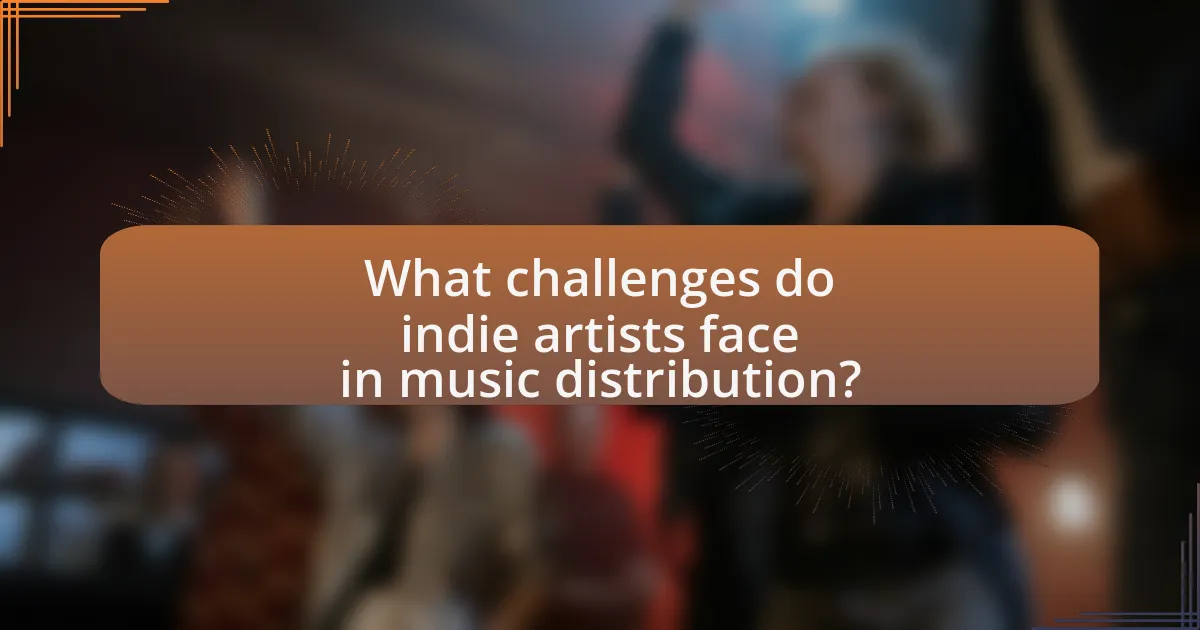
What challenges do indie artists face in music distribution?
Indie artists face significant challenges in music distribution, primarily due to limited resources and market visibility. These artists often lack the financial backing and marketing expertise that major labels provide, making it difficult to reach a wider audience. According to a 2021 report by the International Federation of the Phonographic Industry, independent artists account for only 12% of global recorded music revenue, highlighting the struggle for visibility in a saturated market. Additionally, the complexity of digital distribution platforms can overwhelm indie artists, as they must navigate various services and fees, which can further hinder their ability to effectively distribute their music.
How do financial constraints affect indie music distribution?
Financial constraints significantly limit indie music distribution by restricting access to marketing, production, and distribution channels. Indie artists often lack the budget for professional recording, which can lead to lower-quality music that is less competitive in the market. Additionally, limited funds hinder promotional efforts, reducing visibility on platforms like social media and streaming services. According to a 2021 report by the Music Industry Research Association, 70% of independent musicians cited financial limitations as a primary barrier to effective distribution. This lack of resources can result in fewer opportunities for collaborations and partnerships, further isolating indie artists from broader industry networks.
What are the common funding sources for indie artists?
Common funding sources for indie artists include crowdfunding platforms, grants, music licensing, merchandise sales, and private investors. Crowdfunding platforms like Kickstarter and Indiegogo allow artists to raise funds directly from fans, often in exchange for exclusive content or rewards. Grants from organizations such as the National Endowment for the Arts provide financial support for specific projects. Music licensing opportunities, where artists earn money by allowing their music to be used in films, commercials, or video games, also serve as a significant revenue stream. Additionally, merchandise sales at concerts and online contribute to funding, while private investors may provide capital in exchange for a share of future earnings. These sources collectively enable indie artists to finance their projects and sustain their careers in a competitive industry.
How can artists manage their budgets effectively for distribution?
Artists can manage their budgets effectively for distribution by creating a detailed budget plan that outlines all potential costs associated with distribution channels. This includes expenses for digital distribution services, marketing, promotional materials, and any fees related to physical distribution if applicable. According to a 2021 survey by the Music Industry Research Association, 65% of independent artists reported that having a clear budget helped them allocate resources more efficiently and maximize their reach. By regularly reviewing and adjusting their budget based on actual expenses and income, artists can ensure they remain financially viable while effectively promoting their music.
What legal issues should indie artists be aware of in distribution?
Indie artists should be aware of copyright infringement, licensing agreements, and distribution contracts when distributing their music. Copyright infringement occurs when an artist’s work is used without permission, which can lead to legal disputes and financial penalties. Licensing agreements are essential for allowing the use of music in various media, and artists must ensure they have the appropriate licenses for distribution platforms. Additionally, distribution contracts often contain terms regarding royalties, rights, and obligations that can significantly impact an artist’s revenue and creative control. Understanding these legal issues is crucial for indie artists to protect their work and navigate the complexities of music distribution effectively.
How can copyright laws impact indie music distribution?
Copyright laws significantly impact indie music distribution by determining how artists can legally share and monetize their work. These laws protect the intellectual property of musicians, ensuring they receive compensation for their creations. For instance, the Digital Millennium Copyright Act (DMCA) provides a framework for copyright protection in the digital space, which is crucial for indie artists distributing music online. According to a 2021 report by the International Federation of the Phonographic Industry (IFPI), 70% of independent artists rely on digital platforms for distribution, making compliance with copyright laws essential for revenue generation and legal protection. Thus, understanding and navigating copyright laws is vital for indie musicians to effectively distribute their music while safeguarding their rights.
What are the best practices for navigating licensing agreements?
The best practices for navigating licensing agreements include thoroughly understanding the terms, seeking legal advice, and maintaining clear communication with all parties involved. Understanding the terms ensures that all rights and obligations are clear, which is crucial for compliance and avoiding disputes. Seeking legal advice from professionals experienced in licensing can help identify potential pitfalls and ensure that the agreement aligns with industry standards. Clear communication fosters transparency and can prevent misunderstandings that may arise during the licensing process. These practices are essential for protecting intellectual property and ensuring successful collaborations in the indie music distribution landscape.
What practical strategies can indie artists adopt for successful distribution?
Indie artists can adopt several practical strategies for successful distribution, including leveraging digital platforms, utilizing social media for promotion, and collaborating with other artists. Digital platforms like Spotify, Apple Music, and Bandcamp provide indie artists with direct access to global audiences, allowing for easy distribution of their music. Social media channels, such as Instagram and TikTok, enable artists to engage with fans, share their music, and create viral marketing opportunities. Collaborating with other artists can expand reach and introduce new audiences, enhancing visibility and potential sales. These strategies are supported by the fact that over 60% of music listeners discover new artists through streaming services and social media, highlighting the importance of these distribution methods in the current music landscape.
How can building a strong online presence enhance distribution efforts?
Building a strong online presence enhances distribution efforts by increasing visibility and accessibility to a broader audience. A well-established online presence allows indie artists to reach potential listeners through various digital platforms, such as social media, streaming services, and music blogs. For instance, according to a 2021 report by the International Federation of the Phonographic Industry, 70% of music consumption now occurs through streaming platforms, highlighting the importance of being visible online. Furthermore, effective online marketing strategies can lead to higher engagement rates, which directly correlate with increased sales and distribution opportunities. Thus, a robust online presence not only facilitates direct access to fans but also strengthens partnerships with distributors and platforms, ultimately enhancing overall distribution efforts.
What role does networking play in the success of indie music distribution?
Networking is crucial for the success of indie music distribution as it facilitates connections between artists, industry professionals, and audiences. These connections enable indie musicians to access resources such as promotional opportunities, collaborations, and distribution channels that are often not available through traditional means. For instance, a study by the Berklee College of Music found that 70% of independent artists attribute their success to networking efforts, highlighting the importance of building relationships within the music industry. Additionally, platforms like social media and music festivals serve as networking hubs, allowing indie artists to showcase their work and engage with potential fans and collaborators, further enhancing their distribution success.
